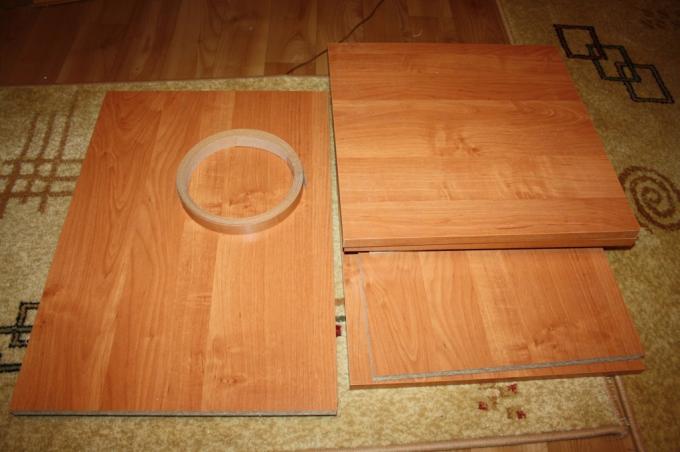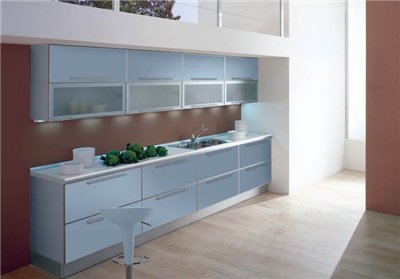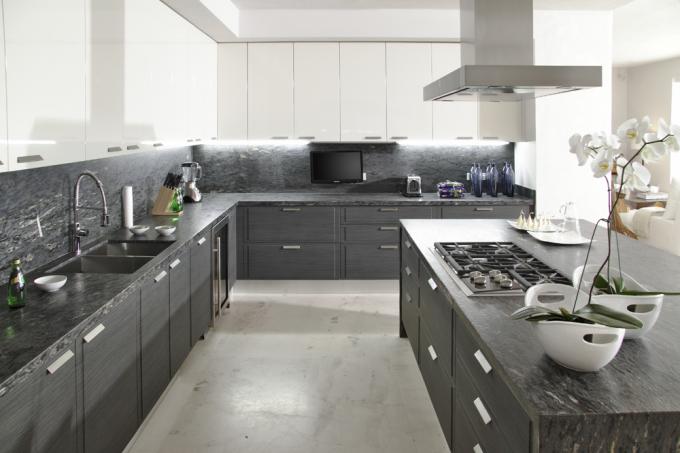Content
-
1 Preparation for the manufacture of countertops
- 1.1 Materials for the frame and countertops
- 1.2 Tools
- 1.3 Frame and formwork
-
2 Countertop manufacturing
- 2.1 Preparation and pouring of the solution
- 2.2 Countertop finishing
- 3 Benefits of homemade countertops
Kitchen countertops in furniture stores amaze with their attractive appearance, variety of models, and, alas, price. However, if you need a budget kitchen countertop, you can make it with your own hands in just a few days.

Homemade countertop
At the same time, the budget, in any case, does not mean a deterioration in appearance or performance. If you do everything right, the new kitchen countertop will delight you and your household for many years!
Preparation for the manufacture of countertops
Materials for the frame and countertops
If you need a do-it-yourself kitchen countertop, then first of all you need to decide which coating will suit us best. In this article we will describe the production of two types of worktops - with a marbled finish (as in the photo) and with tiles. The manufacturing technology of such countertops has already been worked out, so you can safely follow the recommendations given in the article.
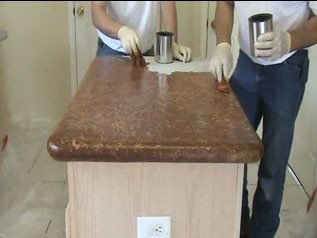
Table top "marbled"
So, to make a countertop, we need to buy:
- Timber for the frame - preferably 40x50 or 50x50 mm, made of even and whole wood. The higher the quality of the timber, the easier it will be for us to cover it later.
- Sand, cement, crushed stone - for the manufacture of the base under the countertop.
- Metal rods - for countertop reinforcement.
- Plasticizers and pigments for concrete.
- Boards (almost any, if only whole and even) for the manufacture of formwork.
- Aluminum or plastic profile for finishing the edge of the table top.
- Liquid Nails.
If you plan to finish the surface of the countertop with tiles, then we will need the tile itself, glue for it, and also a compound for grouting.
Advice! We recommend choosing the highest quality grout, since the seams on the surface of the countertop will be subjected to increased stress.
As you can see, we do not need very expensive materials - and therefore the price of a homemade countertop will be much lower.
Tools
Despite the fact that a do-it-yourself kitchen countertop is made without the use of any complicated tools (with one exception), do we still need something?
- Drill or screwdriver - for assembling the frame and formwork.
- Electric jigsaw.
- Grinder with cut-off wheel.
- Trowel and trowel for working with concrete.
- Tile trowel.
- Tile cutting machine.
- Roulette and level.
In addition, if we are going to make a table top "marbled", we will need a sander with a power of 1000 W or more.
Frame and formwork
After all the materials have been purchased, you can start creating the frame for our countertop. Since the countertop based on a concrete slab has a significant mass, it will not work to install it on standard kitchen modules - a special frame will be needed.
We do it this way:

Assembling the frame
- We determine the height of our future countertop.
- We cut off fragments of the appropriate length from the beams 50x50 mm - they will serve as the vertical racks of our frame.
- We fasten the vertical posts to the floor using metal corners. Where the racks are adjacent to the walls, we drill through them and fix them with anchor dowels.
- Having installed the racks, we connect them with horizontal jumpers, assembling the frame of the frame. The frame can be reinforced with diagonal braces.
Advice! The frame of the frame can be checked by sitting on top of it. If it does not stagger and does not change its configuration, then there is no need to further strengthen the frame.

Formwork under the countertop
- From the boards we make the lower part of the table top and the formwork around the perimeter. We assemble the formwork in such a way that it can be removed without damaging the concrete itself.
- Inside the formwork, in the place where the sink will be located, we lay a ring of metal strip. If you plan to install a hob, we also lay out metal or wood sides around its perimeter.
- We cover the entire formwork with polyethylene, since we will make the solution quite liquid, and we need to protect the floor from leaks.
Countertop manufacturing
Preparation and pouring of the solution
Our formwork is ready - you can start making the base for our worktop:
- We put reinforcing rods connected to each other in the formwork. The better the fittings are, the more reliable our tabletop will be.
- We prepare a solution by mixing cement, sand and crushed stone in a 1: 2: 2 ratio. To improve the quality of the solution, we add a plasticizer. We dilute the solution with water until a creamy consistency is obtained - the solution should spread easily enough.
- If we decide to make a countertop out of imitation marble or granite, we add a special pigment to the solution. These pigments can be purchased at almost any hardware store.

Pigments for concrete
Advice! To obtain a beautiful granite texture, we first dilute the pigment with water, and only then add it to the solution itself.
- Pour the finished solution into the formwork to the desired height, controlling the level of the horizontal surface. We level the solution, cover it with a film, and then leave it to dry for 7-10 days.
- To make the tabletop as strong as possible, you need to prevent it from drying out when the solution hardens. For this, we periodically control the surface of the countertop, and, if necessary, moisten it from the spray bottle.
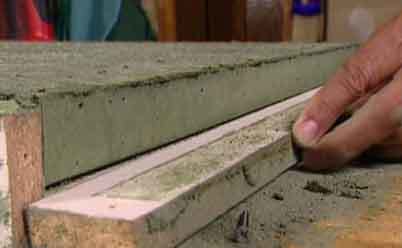
Removing the formwork
After the mortar has completely hardened, you can remove the formwork and start finishing the countertop.
How to make corner countertop for the kitchen, read the article on the site.
Countertop finishing
The final stage of manufacturing is the finishing of the countertop. Here we describe two finishing methods - tiling and polishing of decorative concrete. The process of finishing the countertop is shown in detail in the video.
Tiling is done as follows:
- Using a float, apply tile adhesive to the countertop. We distribute the glue evenly and form grooves on it for more effective gluing of the tiles.
- The selected tile (preferably rather strong, smooth, with a matte surface) is laid on the adhesive layer and pressed, carefully leveling it along the plane.
- Using plastic crosses, align all the seams between the laid tiles in width.
- After laying the tiles, we wait for the glue to dry completely and rub the seams.
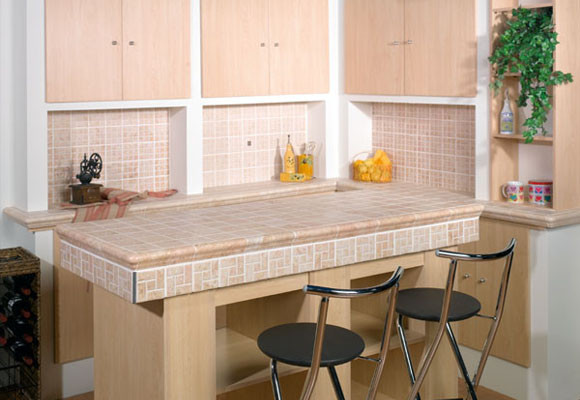
Tiled worktop
- At the same stage, we install a profile on the ends of the countertop, fixing it with tile glue or liquid nails. In order for the profile to be securely fixed, we fix it using clamps.
The advantage of this finishing method is that repairing a kitchen countertop with your own hands will consist in removing the damaged tile and replacing it with a similar one.
To make a countertop, the surface of which imitates natural stone, is somewhat more difficult:

Surface polishing
- First, grind the concrete surface with added pigments with a coarse-grained nozzle of a grinding machine, achieving a perfectly flat surface.
- Then we repeat the operation using a disc with a finer grain.
- Dust the surface and treat it with a special impregnation - sealing. This impregnation is often sold under the name concrete filler.
- Putting suede on the disc of the grinder, we polish the tabletop at low speeds, achieving a mirror shine.

Sealing for concrete
The advantage of this finishing method is that you don't have to rack your brains thinking about how to update your kitchen countertop with your own hands. A worn countertop just needs to be sanded again and it will be like new!
More information in the article Artificial stone countertops for the kitchen: first acquaintance.
Benefits of homemade countertops
This instruction will help you master the technology of making homemade countertops. And besides the fact that you will get the opportunity to significantly reduce costs, you can still:
- Choose the shape and color of the countertop yourself.
- Control the quality of worktop manufacturing at all stages, making adjustments if necessary.
- To make a really durable countertop that will not be afraid of moisture, high temperatures, or mechanical damage.
Well, among other things, handmade furniture looks somehow special - doesn't it?
Useful information in the material Kitchen countertops: the variety is impressive.
Summing up, I would like to note once again that a kitchen countertop with our own hands can be made even by those of us who have never been involved in the production of kitchen furniture. Therefore, do not be afraid - study the recommendations given and get to work!
